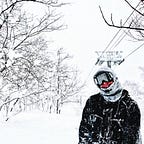Is Exploration Dead?
Earlier this year, Australia day morning in fact, I awoke excitedly as I was about to embark on my annual holiday to my favourite destination on the planet: Japan. This year’s destination was to the fabled Niseko mountains. Situated on the country’s north island, the area is known for its extreme amounts of unfathomably light snow. Returning for the first time since 2012, my memory of Niseko was of a quaint town that had a few westernised modifications to help ease the cultural shock of the small amount of visiting tourists, predominantly from Australia.
Approaching the town, my excitement that has lasted for months was soon turned into sheer disbelief. The small village that I remembered as purely Japanese in essence, had been turn into a westernised architectural haven that now is referred to as the Aspen of Japan.
Social Media, as I am sure you are well aware, has developed immensely since my last visit in 2012, so too had the publicity Niseko received via these platforms. I was aware that Australians were increasingly opting to travel overseas. I was aware that travel companies nationally had a seemingly endless amount of advertised travel deals to get us over there for a fraction of the price it would cost to get to North America. I was aware each year I had friends or family choosing Niseko as the destination for their first overseas snow getaway.
Still, I couldn’t help but feel an overwhelming sense of disappointment while walking the highly developed streets for the first time in almost a decade. I questioned myself who was to blame for turning this once hidden gem into a capitalist’s haven. As someone who studies media, I couldn’t help but think that my beloved platforms were to blame and wondered how many other secret sanctuaries had been foiled due their high levels of Instagrammability.
It is no secret that the way in which we as a society live our day to day lives is heavily affected by social media and its affordances. Holiday destinations are no exception to that. A recent study conducted found that in 2017, over 40% of the 18–33-year-olds surveyed stated that they based their holidays destinations around how well the content taken there would translate over to social media platforms. In short, whatever location deemed to be the most ‘like worthy’ prevailed.
A concrete example of this is Norway’s (now) infamous Trolltunga. An awe-inspiring cliff that is situated roughly 1100 metres above sea level that is only accessible via a twenty-five kilometre hike. According to National Geographic Magazine, the number of annual Trolltunga visitors had increased exponentially from a mere five-hundred in 2008, to over forty-thousand in 2014. This increase in tourism correlates directly with the implementation and popularisation of Instagram.
What that beautiful, picturesque photo at the edge of the cliff which is well on its way to hit 1k likes doesn’t show you, is the congested highway of people throughout the littered, beaten track that wraps around dangerous cliff faces where one misstep can have major consequences. My housemate Tom visited Trolltunga during the summer of last year and said the last kilometre or two of the hike was terrifying due people pushing and trying to get passed you on extremely narrow ways where a few feet away is the edge of a cliff. In 2015, a young Australian Kristi Kafcaloudis, in a terrible tragedy lost her footing at the top of the cliff, slipped and fell to her death. Thomas Ruud, owner and operator of a tour guide service at Trolltunga, was not surprised upon hearing this news and stated it was a tragedy waiting to happen. He had been left dumbfounded time after time over the years regarding the attire he saw people attempting the climb in. Tom was following a woman in heels!
Obviously each situation similar to Trolltunga’s is unique in its right perspective and comes with both pros and cons. The financial benefits that accompany increased tourism can be imperative for the sustainment of some communities. Iceland’s Reykjavik was on the brink of collapsing following a severe banking and financial crisis in 2008. Through government initiated tourism advertising utilising social media, the country quadrupled its amount of tourists in just a few short years. Today, it is estimated one in every five people throughout the country during summer is a tourist and forecasts roughly 2.3 million for the upcoming summer, a 30% increase since 2016. This fact has posed serious concerns shown by the locals as the sustainment of their beloved city is coming into question.
You may be reading this and now thinking, “so should I just stop travelling?” Of course not! But like everything in the modern world we live in we must be mindful of our actions. Popular travelling photographer Chris Burkard, who has over 3.4 million Instagram followers, recommends one way to combat this is by researching and visiting less showcased areas or spots. This allows that person to have their own unique experiences rather than mimicking someone else’s.
So next time you’re planning a holiday, maybe stray away from what destinations are trending on your various platforms and dive deeper into the research of countries that interest you. Spin a globe and point to a country if that works. It is a big, bad world out there with plenty of exploring left in it.
